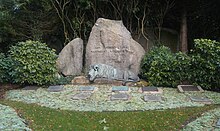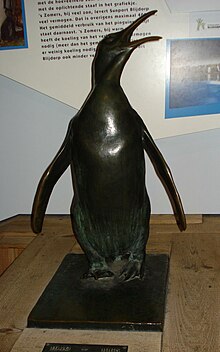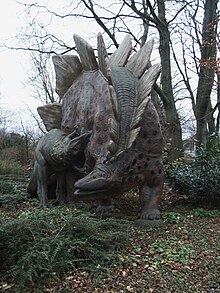Josef Pallenberg

Josef Franz Pallenberg (born August 6, 1882 in Cologne , † June 26, 1946 in Düsseldorf ) was a German sculptor who was best known as an animal sculptor.
Life
Josef Jupp Pallenberg comes from a well-known Cologne artist family. Josef Pallenberg is the eldest son of Maria and Jean Pallenberg, a nephew of Johann Heinrich Pallenberg , an art carpenter and furniture manufacturer and purveyor to the royal Prussian court .
Josef Pallenberg began drawing animals at the age of six, excited by a visit to the Cologne Zoo . From 1899 he attended the Düsseldorf Art Academy , where he received his first training in drawing from Ernst Roeber and Willy Spatz . He immediately switched to the class of the sculptor Karl Janssen , where he created his first important work, the Sauhatz , which was shown in 1902 in the Kunstpalast Düsseldorf as part of the large trade and industrial exhibition. Proposed for the Golden State Medal, he was refused this award because his sculpture was "just a student's work". In 1904 Pallenberg was represented at the Great Berlin Art Exhibition with 16 animal sculptures. In 1907 the bronze sculpture Flying Eagle received a small gold medal at the Great Berlin Art Exhibition .
Pallenberg left the art academy and went to the Berlin Zoological Garden , where he found a supporter and sponsor in Ludwig Heck . During this time he created a large number of impressive animal sculptures. This is how Carl Hagenbeck became aware of Pallenberg and commissioned him to manufacture the animal bronzes for the entrance gate of the zoo, which opened in 1907. In 1909 he designed a number of life-size concrete dinosaur sculptures for the Hagenbeck dinosaur park , which at the time was unique for a European zoo.
In his studio in Cologne, in addition to the work for Hagenbeck, he created the Rominter Runfthirsch , which received the Golden State Medal at the 1907 National Art Exhibition . This sculpture is still on display in the Berlin Zoological Garden today. A replica of it was bought in 1908 by the Düsseldorf Beautification Association and set up in front of the Düsseldorf court gardener house. The Roaring Deer has stood in the northern part of the Düsseldorf court garden , parallel to Kaiserstrasse, since 1956 .
Josef Pallenberg, who kept models living in his studio near the Cologne Zoo, such as a wild boar, a tame lioness named "Juste" and a tame wolf named "Prinz", increasingly attracted the "displeasure" of his neighborhood, when he walked these animals on a leash. In 1909 he found a new studio in Düsseldorf-Lohausen (Niederrheinstraße 239) , in which he could develop freely and in 1912 set up his small private zoo. His younger brother Christian helped him look after the animals until he was called up for military service. In 1915, her widow friend, Maria Steinhausen (née DuMont), moved with her 15-year-old daughter to Josef Pallenberg. From then on, the women took care of the artist's household and animals, which gave Pallenberg the opportunity to devote himself fully to his work. In 1917 Josef Pallenberg and Maria Steinhausen married.
Josef Pallenberg went on extensive study trips, mainly to the USA , and created works in the zoos of Detroit and Cincinnati.
During the Second World War , Pallenberg had to part with a large number of his animals, such as his beloved lion "Hassan", due to lack of food. Pallenberg's house and studio were also badly damaged by an aerial bomb and a large part of his work, drawings and anatomical collection was lost. The remaining part, consisting of 575 sculptures made of plaster of paris, clay, cast stone and bronze and around 1,300 hand drawings, were loaned to the Löbbecke Museum .
After Pallenberg's death in 1946, the museum was given the natural science collection of 62 skeletons, 882 skulls, 302 natural casts and reconstructions from the heirs as a gift. Josef Pallenberg and his wife were buried in the Lohausen cemetery under a boulder with a bronze eagle enthroned.
Pallenberg was never a member of an artists' association and remained true to his style as a scientifically working artist throughout his life. One of his techniques was to make lifelike, precise, and detailed casts of dead animals. Zoologists in particular valued his close-to-nature work. A chronological classification of his works is difficult today, as Pallenberg almost never dated his works and bronze casts were often made much later. It is just as difficult to delimit individual creative periods, only in the later phase of his work are some slightly impressionistic "excesses" to be observed. It can no longer be clarified today whether this was deliberately intended by the artist or whether this can be explained with the progressive deterioration of his health.
One of Josef Pallenberg's younger brothers was Emil Pallenberg, who became known for his trained bears .
After the Second World War, the sculptor Arno Breker moved into Josef Pallenberg's studio on Niederrheinstrasse in Düsseldorf-Lohausen.
After the exhibition on Pallenberg's life and work was opened in 2013 in the Natural History Museum of the Benrath Castle and Park Foundation , a permanent exhibition was set up in January 2018 that can be visited on Saturdays and Sundays.
On February 17, 2019, an episode of the NDR's Lieb & Teuer program was broadcast, moderated by Janin Ullmann and filmed in Reinbek Castle . A bronze sculpture of a Pallenberg red deer from 1905 was discussed with the art historian Stephan Schwarzl.
estate
literature
- O. Bauer: A modern animal sculptor . With 12 illustrations based on original photographs. In: Reclams Universum 26, 1910, pp. 591-596.
- Pallenberg, Josef Franz . In: Hans Vollmer (Hrsg.): General lexicon of fine artists from antiquity to the present . Founded by Ulrich Thieme and Felix Becker . tape 26 : Olivier – Pieris . EA Seemann, Leipzig 1932, p. 168 .
- Horst Sieloff: Josef Pallenberg and his animals. A cross-section from the work of the Düsseldorf animal artist on his 80th birthday . 1962.
- H. Rudolf Mückler: Josef Pallenberg 1882-1946. His life, his art, his animals . Bongers, Recklinghausen 1992, ISBN 3764704330 .
- Martin Bartelmus, Stefan Schweizer: The animal sculptor Josef Pallenberg (1882-1946) = The animal sculptor Josef Pallenberg (1882-1946) , Berlin: Deutscher Kunstverlag [2020], ISBN 978-3-422-97983-3 .
Web links
- Animal sculptor
- Article (PDF file; 27 kB)
Individual evidence
- ↑ a b Schloß Benrath.de - Josef Pallenberg Collection (1882-1946) , accessed on January 31, 2015
- ^ Wieland Koenig (Ed.): Düsseldorfer Gartenlust . Catalog of the city museum of the state capital Düsseldorf for the exhibition of the same name, Düsseldorf 1987, p. 134 (catalog number 6.91)
- ↑ Since January 2018 , exhibitions, schloss-benrath.de
- ↑ Video sculpture red deer by Josef Pallenberg on ndr.de
| personal data | |
|---|---|
| SURNAME | Pallenberg, Josef |
| ALTERNATIVE NAMES | Pallenberg, Joseph Franz (full name) |
| BRIEF DESCRIPTION | German animal sculptor and animal sculptor |
| DATE OF BIRTH | August 6, 1882 |
| PLACE OF BIRTH | Cologne |
| DATE OF DEATH | June 26, 1946 |
| Place of death | Dusseldorf |



